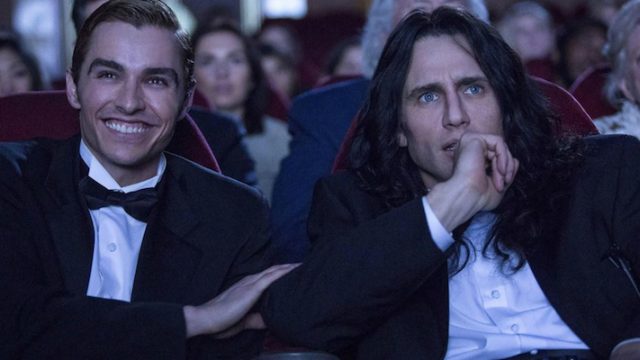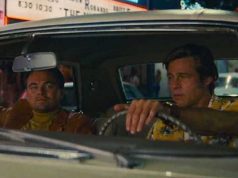
“The Room” (not to be confused with “Room,” about the kidnapped woman and her son) is a thoroughly incompetent melodrama from 2003 that won the pop-culture lottery by becoming a cult favorite. Dozens, if not hundreds, of movies this bad are made every year; most are never seen by anyone but the people who made them and the poor wretches who view film-festival submissions. “The Room,” on the other hand, plays regularly to sellout crowds, taking on a “Rocky Horror Picture Show” vibe as fans bring relevant props and shout out their favorite lines.
(Side note: I cannot think of a worse way to see a movie for the first time than with an audience full of people who have seen it before and are yelling along with it. That is my personal nightmare. GOOD DAY.)
With all that “success,” even the kind with ironic quotation marks, you can see why Tommy Wiseau, the enigmatic weirdo who semi-wrote, quasi-directed, and fails to star in it, is so pleased with himself. He came to Hollywood to make a movie that would be profitable and memorable, and “The Room” is both of those things. That it achieved its fame only by being so catastrophically bad that people would tell their friends, “Oh my gosh, you have to see how bad this movie is!” is beside the point.
“The Disaster Artist” is a funny and highly energized dramatization of how “The Room” came to be, based on Wiseau’s friend and co-star Greg Sestero’s book about the experience. James Franco, ever a fan of outsider art, irony, and an excuse to be naked, directed the film and plays Wiseau, with his brother Dave as Sestero and a host of pals in other roles. It’s a good, shallow movie about a bad, shallow movie, and about the kooky characters who move to Hollywood to pursue their wholly unrealistic (but you never know!) dreams.
It begins in San Francisco in 1998, with timid, naive 19-year-old Greg Sestero taking acting classes and trying to parlay his good looks into a career. Wholesome and gregarious, Greg is fascinated by new classmate Tommy Wiseau, a stringy-haired ham with an indiscernible accent, boundless confidence, and not a shred of talent. Tommy won’t tell anyone where he’s from (he says New Orleans and denies having an accent), claims to be Greg’s age (he’s clearly at least 15 years older), and deflects all biographical questions (including how he seems to have unlimited financial resources) as too personal. His acting is atrocious, but he’s sincere and fearless, lacking all sense of embarrassment — a quality Greg needs to adopt.
We would suspect that Tommy’s interest in Greg (whom he calls “Baby Face”) is prurient, especially when he proposes they move to L.A. together, except that Tommy is too ludicrous to be creepy. Franco’s impersonation of the guy’s dented English, drunken enunciation, and inscrutable mannerisms is spot-on, yet even having seen “The Room” I had a hard time accepting that Tommy was a real person and not a character in a comedy sketch. I suspect that’s what it’s like to know the actual Tommy Wiseau. You’re always asking yourself, “Is this guy for real?”
“The Disaster Artist” can’t answer that question, so don’t get your hopes up. Told mostly through Greg’s eyes, it takes us through the process of Tommy writing his own screenplay, hiring the first crew members who apply, casting some actors, and making “The Room.” Since he’s the boss and his checks don’t bounce, everyone caters to his insane whims, like shooting in HD and 35mm, or building a set of an alleyway that’s identical to an actual alley just outside the studio doors. The 40-day shoot drags on for much, much longer. The script supervisor, Sandy (Seth Rogen), becomes de facto director for the scenes that Tommy is in, and he and the cinematographer, Raphael (Paul Scheer), become our surrogates as they watch the process and constantly ask, “WTF?”
Turns out Tommy can’t remember his lines (which he wrote). Though playing a character, he insists on wearing his own eccentric clothes. He insists on being nude for a love scene that doesn’t require full nudity, on making sure his naked butt is visible on camera, and on directing it in the buff, too. Franco plays up the absurdity of all this, presumably aware of the irony in being gratuitously naked as he directs and stars in a film about a delusional idiot who directed and starred in a film while gratuitously naked.
But the screenplay, adapted from Sestero’s book by Scott Neustadter and Michael H. Weber (“500 Days of Summer”), laughs off Wiseau’s mistreatment of the nude actress involved, Juliette Danielle (played by Ari Graynor). He’s hypercritical of her physical appearance and refuses to close the set to protect her privacy, indignities that in another story would be our reason for hating a character. Here, well, it’s just that nutty Tommy! Whaddaya gonna do? Wiseau’s other abuses, like refusing to air-condition the sweltering studio until a nice mom-aged actress (Jacki Weaver) passes out, are similarly played for laughs, and there’s no mention of the fact that many cast and crew members were replaced over the course of the production, some of them multiple times. We knew “genius” directors could get away with anything; who knew they didn’t even have to be talented?
Those familiar with “The Room” will be satisfied to find many of its peculiarities explained in this behind-the-scenes account, but Franco was smart not to focus on that. This isn’t the making of “Casablanca”; even given its cult following, how many average moviegoers have actually seen “The Room”? It’s Dave Franco as Greg who holds our emotional investment, a loyal and forgiving friend who doesn’t get fed up with Tommy’s exhausting nonsense until much later than we would have. Their friendship — or at least Greg’s side of it — is sweet, made more so by the actors’ brotherly connection.
With familiar faces at every turn, many of them in minor roles — Megan Mullally, Nathan Fielder, Jason Mantzoukas, Zac Efron, Josh Hutcherson, Hannibal Buress, Bob Odenkirk, Jerrod Carmichael, Sharon Stone (!), Melanie Griffith (?!), etc., etc. — there’s the pervasive sense that this is all just a well-executed lark by the Francos and their friends (also including Dave’s wife, Alison Brie, who plays Greg’s girlfriend, of whom Tommy is jealous).
Despite this, “The Disaster Artist” doesn’t feel like an inside joke but an expansive, welcoming comedy aimed at movie fans of all stripes. Don’t expect any insight into what makes a guy like Wiseau tick, or what makes some awful movies so appealing, or anything, really. Just enjoy the experience of making Tommy Wiseau a laughingstock again.
B+ (1 hr., 43 min.; )





